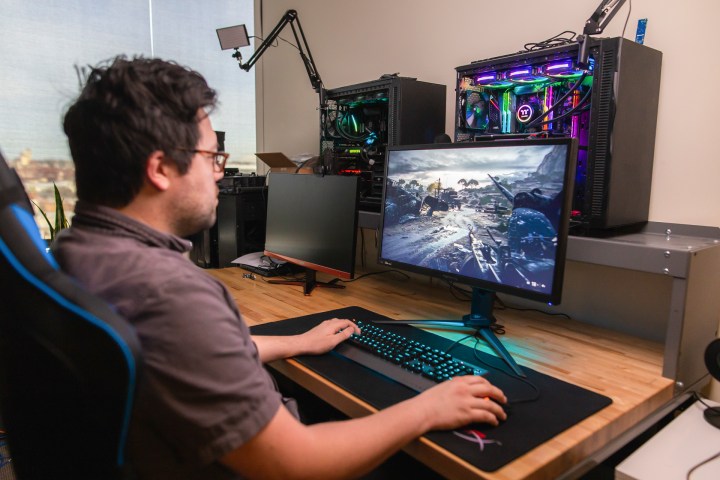Monitors have been behind in innovation for a long time. PC enthusiasts and gamers have watched waves of technological advancement come to televisions, smartphones, and just about every other device with a screen. Meanwhile, we’ve had 1080p IPS monitors for as long as most can remember.
But that’s changing. Monitors are finally getting interesting — whether that’s embracing new display technologies or pushing higher resolutions. In an exclusive interview with the president of digital displays at Acer, we spoke about where this excitement came from and which technologies will be the most dominant in the next few years.
More growth and innovation ahead

Seeing is believing. That seems to be the core belief behind Acer’s investment in the future of monitor technology.
“I believe people will start to appreciate the value of having a monitor at home,” said Victor Chien, who’s been leading Acer’s display products for many years. “I think the growth will still continue.”
The growth he’s referring to, of course, is a surge in demand for monitors that we’ve witnessed over the past year. More people working from home means more need for external monitors that their workplace may have previously supplied.
Chien says that in previous years, the monitor market has been flat, with refresh cycles being quite long. The majority of a person’s technology budget went into their PC or laptop — leaving little concern for the quality of their displays. If people are only buying monitors every 10 years, you can’t expect companies like Acer to care about investing in innovative new technology.
“Gaming displays are really driving the technology.”
But these days, monitors are more exciting than ever. Some are curved, some are ultrawide, some have high resolutions, other have extremely fast refresh rates. What happened? Well, Chien seems to believe gaming monitors deserve a lot of the credit for kick-starting demand for these more advanced features.
“Gaming displays are really driving the technology to make the end user refresh,” he told me. “To have a bigger display, to have a better viewing experience.”

As graphics cards have increased in capability over the past year, we’re finally seeing wider adoption of 1440p and 4K along with refresh rates that we could have never imagined just five years ago. The power of modern-day PCs is pushing the bounds of what older displays can handle. The result? Gamers going out and dropping loads of cash on monitors that can actually support their powerful new gaming rigs. Between the pandemic and the latent potential in these new gaming systems, there’s finally reason to start refreshing your monitor more regularly.
Chien even made the point that the pandemic was making extra-large gaming monitors a more viable option. More people at home means sharing more of the available screens. That means something like the new 43-inch large-format gaming display launched by Acer doesn’t need to necessarily compete with televisions. It has its own niche, and it’s finally starting to make some sense in the context of the shared spaces of a home.
That doesn’t mean 43-inch monitors that probably won’t fit on your desk are the future of PC gaming. There’s a bigger trend on the horizon that will have a much larger impact on the displays we’re all using a few years from now.
The mini-LED revolution is coming

Mini-LED is nothing new. As an upgrade to LED and an alternative to OLED, mini-LED has already made an impact on televisions. The first monitors are already breaking into the gaming space, such as the Asus ROG Swift PG32UQX and the recently announced Acer Predator X32. We’ve even seen the technology on Apple products like the Pro Display XDR, the company’s notoriously expensive external monitor for creatives.
These are all high-end products, of course, and their prices make them out of reach for the average person. But like all worthy technology, this new type of backlighting should eventually come down in price and make its way to the masses. We’re already seeing it in products like the new iPad Pro and gaming laptops like the Acer Predator Triton 500 SE. It seems like it’s only a matter of time.
What’s so great about mini-LED? Because it’s based on LED technology, Chien seems confident that the manufacturing infrastructure is there to rapidly produce mini-LED screens for everything from iPads to gaming monitors. But for Chien, the real perceived value of the transition is all about color.
“We believe the next trend will focus on color,” said Chien, “and how it makes a display have a better viewing experience.”
Mini-LED uses lots of small LEDs to improve image quality over traditional flat-panel LED. Apple’s mini-LED display on the iPad Pro, for example, uses 2,596 local dimming zones, allowing for brighter screens with more precise backlighting. The result is brighter displays, yes, but also increased contrast and color gamut.
“We believe the next trend will focus on color.”
Color might sound like a strange next trend to tackle for gaming monitors. As Chien stated, it’ll only be a few years before higher resolutions become adopted as the mainstream option, in the same way that higher refresh rates in 1080p quickly replaced the 60Hz displays of the past. With issues of resolution and frame rate in the rearview mirror, it does make sense that image quality will be the next stop.
Gamers are known for putting performance first, but Acer is depending on that to change in the future. Once we see the brighter, more colorful gaming experiences of the future, as Chien argues, we won’t want to go back. Again, seeing is believing.


